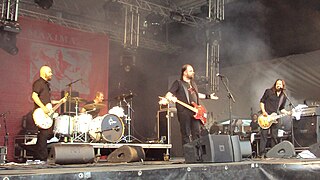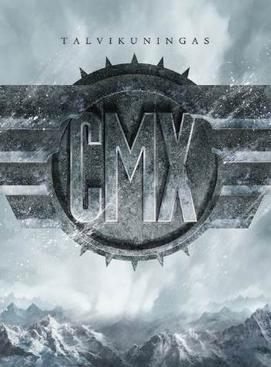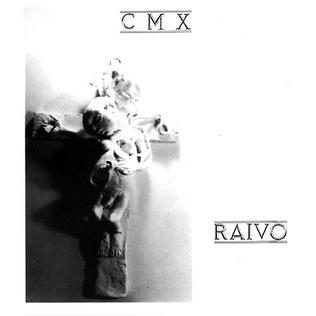
CMX, originally Cloaca Maxima, is a Finnish rock band. They originally played hardcore punk, but soon expanded to play a wide variety of rock formats, including progressive rock, heavy metal, and mainstream rock 'n' roll. Throughout their career, they have been influenced by progressive rock bands such as Rush, Yes, Tool and King Crimson. The progressive influence is most evident on their albums Dinosaurus Stereophonicus (2000) and Talvikuningas (2007).

Ismo Kullervo Alanko is a Finnish musician. He is known as the frontman of several bands, most famously Hassisen Kone, Sielun Veljet and Ismo Alanko Säätiö, as well as a successful solo artist.

Dinosaurus Stereophonicus is the eighth album by the Finnish rock group CMX, released in 2000. It was recorded after the band had decided to stop touring and become a full-time studio band. The decision only lasted until 2002.

Aion (2003) is an album by the Finnish rock group CMX. The word Aion is Ancient Greek for "age, life-force" and also a Finnish verb form meaning "I intend ".

Aura (1994) is an album by the Finnish rock group CMX. The album gained the band its first near-hit single and some commercial airplay with "Ruoste". Although many people consider Aura to be the band's seminal record, at this point many older fans were already scoffing at the more streamlined, acoustic songs and mellow soundscapes as compared to their earlier hardcore steamrolling. However, Aura pretty much defines the band's sound up to this day, with a mixture of heavy and light elements and songwriting reminiscent of 1960s and 1970s progressive rock.

Cloaca Maxima (1997) is the first compilation album by the Finnish rock group CMX. The name Cloaca Maxima means "Great Sewer" in Latin, and was also an early name of the band before it was shortened to CMX. The compilation contains three CDs named Physis, Aetheris and Astralis respectively. Physis, contains rock songs from their albums and EPs, while Aetheris focuses on softer material. The third CD is reserved for B-sides of singles and some new songs recorded solely for the compilation.

Vainajala (1998) is an album by the Finnish rock group CMX. Vainaja is Finnish for a dead person, Vainajala meaning a name of a place inhabited by the dead.
Super Moonies was a German pop group created in 1998 to provide the soundtrack for the successful Sailor Moon anime series, particularly the German-dubbed version. Their songs included "Kämpfe Sailor Moon" and "Macht des Mondes", and sold on compilation CDs with unrelated songs by artists such as Jasmin Wagner and Aaron Carter. Original choreography was created by the same choreographer that choreographed Blumchen's Jasmin Live 1998 Tour. That American Choreographer is Kris Mohfanz.

Discopolis is the sixth studio album by the Finnish rock group CMX.

Isohaara is the ninth studio album by the Finnish rock group CMX. The album is named after Isohaara power plant in Keminmaa. The band spent six months in the studio because of the chosen songwriting method: the songs were written and rehearsed at the studio under constant perfecting and re-arranging. Musically the album is lighter and more accessible than its predecessor, the over 100-minute Prog-epoch Dinosaurus Stereophonicus.

Truly Madly Deeply – Ultra Rare Tracks is a compilation album released by Australian pop duo Savage Garden on 14 April 1998, exclusively in Japan.

Gold is a compilation album by Steely Dan, released in 1982. It mostly comprises hits both post-dating and not included on their 1978 Greatest Hits, essentially acting as "Volume 2"; it also features additional album tracks, offering a broad perspective on the band's career to that point.

"King of Sorrow" is a song by English band Sade from their fifth studio album, Lovers Rock (2000). It was released as the album's second and final single on 12 March 2001.

Talvikuningas (2007) is an album by the Finnish rock group CMX. The title is Finnish and translates to "The Winter King".
"Kultanaamio" is the second single from the Finnish rock band CMX's 1994 album Aura. It also appears on the group's first compilation album Cloaca Maxima. "Kultanaamio" means "Golden Mask" in Finnish.

"Pelasta maailma" is the first single from the CMX album Rautakantele. It also appears on the compilation album Cloaca Maxima. The chorus contains a quote from a poem by L. Onerva. "Pelasta maailma" means "Save the World" in Finnish.

Tanssitauti is an EP by CMX released in 1990. The band had released their debut album Kolmikärki earlier the same year with a different lineup. Tanssitauti is the first CMX recording to feature guitarist Janne Halmkrona, who appears on all of the band's albums from this point on.

Raivo is the second EP by Finnish rock band CMX. It is seen as their heaviest, most aggressive hardcore recording. One song, "Hiki", made it to their 1997 compilation album Cloaca Maxima. The Raivo EP, along with Johannes Kastaja, is included on the 2002 re-release Kolmikärki Gold.

Musiikin ystävälliset kasvot is an EP by CMX. It was recorded in 1991 to be released as a four song EP, but instead the title track was released as a single. The EP was finally released in 1998 under the name Musiikin ystävälliset kasvot + 5 and included six songs. The originally planned four song EP was released in 2002 as a part of Veljeskunta Gold.

Kaikki hedelmät is the third compilation album by the Finnish rock group CMX. It was published on November 5, 2008. Unlike previous two triple compilation albums it concentrates on hits and singles. It includes two new songs that are to be released also separately.


















